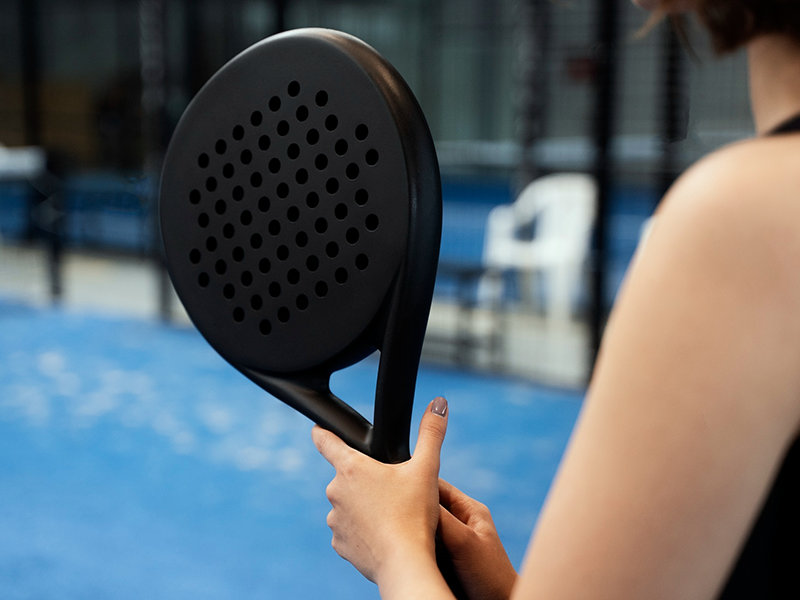Step-by-step plan for choosing the ideal padel racket

Selecting the right padel racket is crucial to getting the best out of your game. Follow this detailed step-by-step plan to make a good choice based on your playing style, experience level and personal preferences.
Step 1: Determine your playing level
Junior (Under 12 years): Choose lighter rackets with a softer material, smaller and thinner grip.
Novice/Recreational players: Choose an easy-to-play racket with a lighter weight, often with a round shape for agility and control.
Intermediate/Experienced players: For regular players, a teardrop racket is an excellent choice, offering a good mix of power and control.
Advanced/Professional players: Choose based on your specific playing style – round shape for defense and control, diamond shape for aggressive playing style and power.
Step 2: Choose the Right Shape
Round Shape: A larger sweet spot and even weight distribution, ideal for beginners looking for control and ease.
Drop shape: Provides speed when hitting and is suitable for intermediate to advanced players.
Diamond shape: Small sweet spot, lots of power; suitable for advanced players with an aggressive playing style and preference for smashes.
Step 3: Consider the Weight
It is wise to try out different rackets to determine which weight suits you best. In general, lighter rackets are often used by children, ladies and beginners. These light rackets are manoeuvrable, offer more control and reduce the risk of injuries. Male players and more advanced players tend to prefer heavier rackets because they generate more power.
Choose the weight that feels most comfortable for you, so that the racket can transmit maximum power.
290-340 grams (light): This category mainly includes junior padel rackets. There are also extra light rackets for adults who are just starting to play padel or are prone to injuries.
340-365 grams (average): Rackets in this weight class are ideal for beginners, but they are also suitable for players who seek agility or are prone to injuries.
365-385 grams (heavy): The weight of men's padel rackets usually varies between 360 and 385 grams. This category is not recommended for beginners or players prone to injuries. Keep in mind that adding overgrips or a protective layer can also add extra weight.
Step 4: Balance the Racket
In addition to weight, the balance of the racket also plays a role in how heavy it feels. A lower balance point makes the racket feel lighter than if the weight is distributed more towards the top of the racket. The general guidelines for the weight of a racket are as follows:
Low: Rackets with a low weight balance have their weight focused more on the grip, making them agile and offering a lot of control. These rackets are often round in shape and suitable for both beginners and advanced players who emphasize precision.
Middle: In the case of rackets with a balanced weight that is more in the middle, a good combination of control and power is created. These rackets usually have a teardrop or round shape and are suitable for a wide range of players.
High: In rackets with a high balance, the weight is closer to the head of the racket, which makes the racket feel a bit heavier. This allows powerful strokes, but can also lead to increased strain on the body, which is especially suitable for advanced and professional players. Such rackets usually have a diamond shape.
Step 5: Understand the Materials
Carbon: Durable, light and powerful. Rackets vary in the amount of carbon incorporated (e.g. 3K, 12K, 18K) – more carbon means more durability and power. Suitable for advanced players.
Fiberglass: Budget-friendly, heavier and softer than carbon. Ideal for beginners due to resilience and placement properties.
Step 6: Consider your Playing Style and Field Position
Defensive: Choose round shape, lower balance, lower weight for more control. Suitable for beginners and advanced players with a defensive playing style.
All-round: Teardrop-shaped racket for a good combination of power and control. Suitable for intermediate players who want to utilize both aspects.
Offensive: Diamond-shaped or teardrop-shaped rackets, higher balance, heavier weight and harder material. Suitable for experienced and advanced players with an aggressive playing style.
Field Position: Generally, the more aggressive player plays on the left side if both players are right-handed. Left-handed players should preferably play on the right side.
By following these detailed steps, you will gain insight into which padel racket best suits your playing style, level and field position. Take the time to try out different rackets and discover which racket suits you best. Have fun on the padel court!
